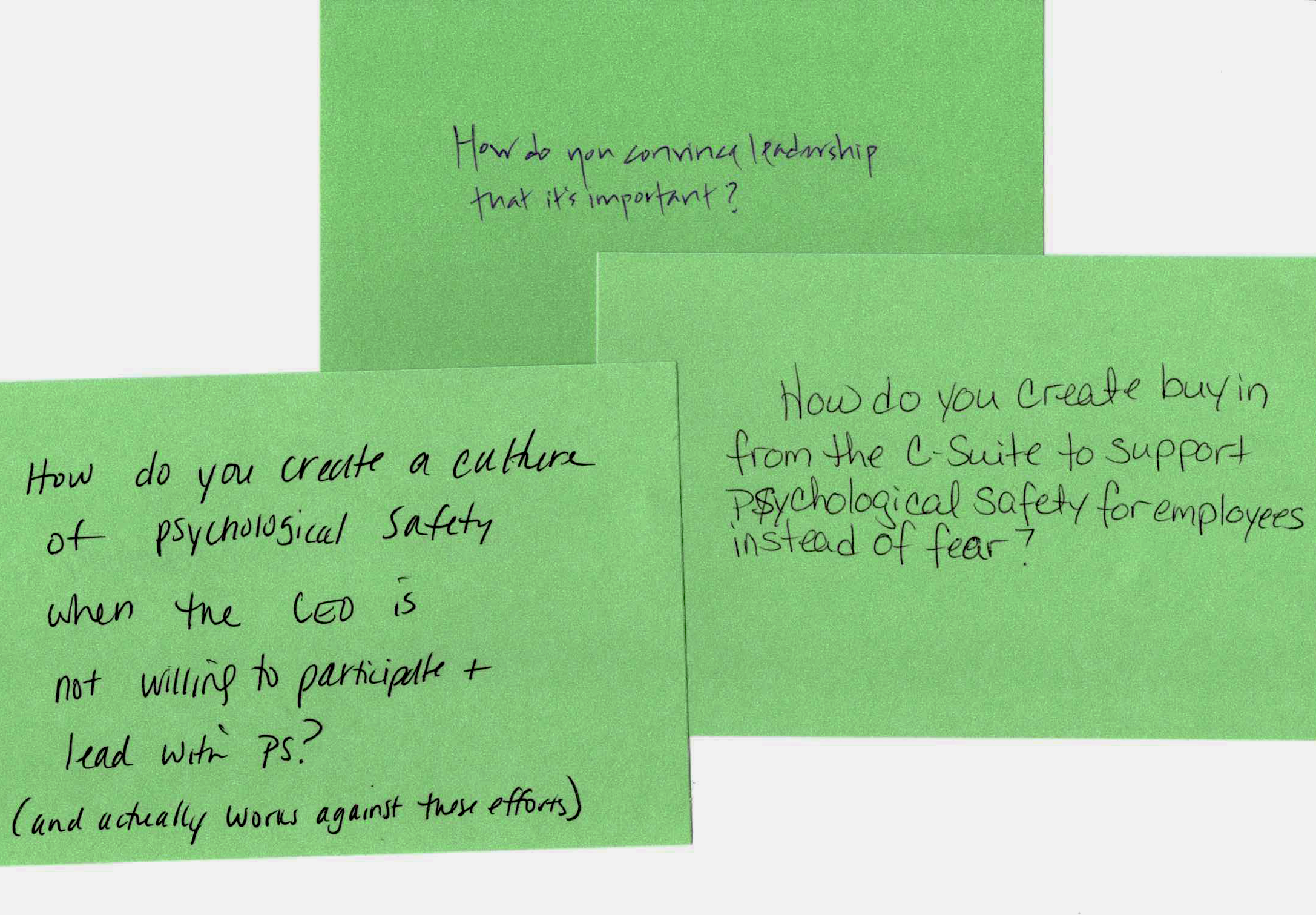How to Get the C-Suite to Take Psychological Safety Seriously

How do we influence leadership — especially when they aren’t on board with creating a culture of psychological safety?
This is a challenge we hear often from leaders at various levels, and it’s a tough one. Whether it’s dealing with a controlling manager, a CEO resistant to change, or an executive team that sticks to the “this is how we’ve always done it” mindset, it can feel like an uphill battle.
We’re diving into how you can manage up and have those crucial conversations with leaders who might see this work as “fluff.”
In addition to the small, everyday actions you can take to move the needle–even when the C-suite isn’t fully on board– here are three proven strategies to help you get buy-in from the top.
1. Tie Psychological Safety to Business Outcomes
Lead with the financials. Often, the person who is ultimately responsible for making sure the organization stays profitable and meets targets wants to hear about business outcomes, not just culture change. The key is to make it clear that psychological safety is not a "nice-to-have" but a must-have for profitability, productivity, and growth. For example:
-
Turnover Costs: Employees who feel unsafe are more likely to leave, and turnover is expensive. Replacing employees costs 1.5 to 2 times their salary. For example, if you have 100 employees and you reduce turnover by just 5%, you could save $1.5 million annually.
-
Productivity Loss: In low-psychological-safety environments, 80% of employees lose work time worrying about workplace incidents, while 48% intentionally decrease their work effort. This underperformance is quietly costing millions in lost productivity every year.
-
Missed Innovation: When employees don’t feel safe to take risks or challenge the status quo, innovation suffers. Teams play it safe and stick to familiar solutions, resulting in missed opportunities. For a competitive company, even one missed product innovation or delayed decision can mean millions in lost revenue.
CEOs understand these financial realities. When you frame psychological safety as a way to save money, boost productivity, and increase innovation, they’ll start seeing it as a business-critical strategy.
2. Link Psychological Safety to Risk Management
One of the strongest arguments for psychological safety is its role in mitigating risk. Executives are ultimately responsible for protecting the company from legal, financial, and reputational harm; a lack of psychological safety opens the door to all of these risks.
CEOs understand these financial realities. When you frame psychological safety as a way to save money, boost productivity, and increase innovation, they’ll start seeing it as a business-critical strategy.
-
Legal and Compliance Risks: When employees feel unsafe speaking up about misconduct, workplace bullying, or unethical practices, it can lead to costly lawsuits and compliance violations. Workplace lawsuits cost an average of $120,000 per case, but larger cases—such as those related to harassment or whistleblowing—can reach nine-figure settlements.
-
Real-World Examples: Boeing’s catastrophic 737 MAX crashes, which cost the company over $20 billion, were partly due to a culture where employees were afraid to report safety concerns. Similarly, Volkswagen’s $30 billion Dieselgate scandal stemmed from employees fearing the consequences of raising ethical concerns about emissions testing. Blockbuster’s resistance to change and fear of innovation led to its failure to embrace streaming, resulting in bankruptcy and billions in lost revenue.
Executives are always looking for ways to reduce risk. Show them that by investing in psychological safety, they can avoid expensive legal battles and protect the company’s reputation.
3. Build a Culture of Psychological Safety - Even When the CEO Isn't On Board
One of the toughest challenges is when the CEO or senior leadership actively resists psychological safety initiatives. However, change doesn’t always have to start from the top - in fact, starting from the middle can have a powerful impact. You can begin fostering psychological safety from the middle of the organization and create pressure from below.
-
Start with Middle Management: Encourage managers and team leaders to start implementing psychological safety within their own teams. Strategies from How to Build Psychological Safety Subtly and Effectively can help you get started with that work. As the benefits of psychological safety—higher productivity, lower turnover, and better team dynamics—become visible, the pressure to expand these initiatives to the rest of the organization will grow.
-
Show Leaders Their Blind Spots: Use the concept of the Iceberg of Ignorance to help leaders understand why they may not be seeing the full picture. A study found that only 4% of executives are aware of problems within the company, while 100% of frontline workers know the issues intimately. This means many leaders are overconfident about how well their teams are functioning. By conducting anonymous employee surveys or using external assessments, you can show leadership what they’re missing—and how it’s impacting the bottom line.
-
Use Data to Convince: If your leadership is skeptical, nothing works better than hard data. Use the Fearless Organization Scan or other assessment tools to measure the level of psychological safety within teams and identify the blind spots. Share those results with executives in concrete, financial terms to show the link between psychological safety, performance, and profitability.
The Bottom Line
Psychological safety is not just a cultural issue; it’s a business strategy. By framing psychological safety in terms that matter to CEOs—profitability, risk reduction, and performance—you can create a compelling case that they can’t afford to ignore.
Even if top leadership is initially resistant, starting from the middle can create the momentum needed for real change. When employees feel safe to contribute their ideas, take risks, and challenge the status quo, everyone wins—including the company’s bottom line.
